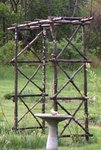The three days of this past weekend were strange indeed. Each day represented a season and ran through time in reverse. I thought of making one posting of what happened but realized the distinctive difference of each required separate postings.
I watch and follow weather news with uncommon zeal. It is a necessary habit for a nurseryman to track weather patterns and trends and how they will affect the immediate surroundings. From the information gathered, plans are made, precautions primed, preparations instituted and actions taken. I knew a storm would be coming during the weekend and tried to think what needed to be done before it arrived.
Number one on my to-do list was fixing the dog enclosure. But before I get to that, let me explain what the dog enclosure is and how we got it. When we moved here, our house was surrounded on two sides by cornfields. Our three dogs never had as much room to run and explore as when we moved here. We vicariously enjoyed the freedom they had and the joy they expressed in living and running, of being.
They are pretty good dogs for the most part. They’re not vicious or mean but are endlessly curious. If a scent needs investigating or they see something, no amount of calling, waving, future threats on their sleeping arrangements or warnings of food withholding will keep them from their chase. It is maddening and frustrating that they do it but we let them get away with it. We don’t want them to act like that but have not trained them to be anything else.
Most rural areas in the country do not have dog ordinances. Dogs are allowed to do what they please within a few parameters: no chasing wildlife (mostly deer and other game animals), no harassing livestock, and no threatening humans. A dog may be shot dead for the first two and written up for the third as a vicious dog. A dog warden can make the determination of removal from the owner, depending on the incident. You’ll notice in each of these cases that action is taken only after something has happened. We wanted to be pro-active and keep our animals from being nuisances, neighborhood bullies and troublemakers. Free-roaming animals annoying people, disregarding property lines and marking territory, harassing and killing livestock, and running after wildlife are what we don’t want our dogs doing. And it’s also a safety issue. Our road has a 55 mph speed limit and dogs and other animals are often maimed and killed.
Our dogs are never outside unless accompanying one of us. This includes all potty and play times, no matter what the weather. We think it is part of being good neighbors and citizens and also being a responsible pet owner. But there are times we would like to have the dogs with us while we are working or exercising outside. As much as I like our pets, I don’t want to spend every moment focused on them. Chores need to be done and most of the time the concentration needed to complete a task precludes being aware of what the dogs are up to.
Our solution was to fence off part of a field and create an enclosed space of safety for the dogs to use. I didn’t want an elaborate (read expensive) or time-consuming project so opted for metal t-posts and vinyl snow fencing. This would give me a lot of flexibility in design and could be quickly built or changed when needed. I used what I call a posthole pounder – a metal pipe closed on one end and two handles at the other end – to drive the posts into the ground. It still takes effort but is much easier than using a hammer or sledge to plant the posts, especially in our stony fields.
Snow fencing comes in two colors – orange or dark green. My choice was dark green but orange was the only color available, so orange it was. After two years you do sort of get used to it. I used zip ties to attach fencing to posts and had it all up in a day. Tip to everyone: use wooden slats or stakes on every post, sandwiching the fencing between. This will prevent tears on the fencing. Also, use the wide part of the fencing, in my case the horizontal bands, when securing with the zip ties. I bet you’ll never guess how I learned about those tips. Yes, my mental how-to manual has been updated as I have learned from my mistakes. The whole area was over sown with grass seed of a play-yard blend. To this day, the grass here is the best on the property.
Now it’s been two and a half years since I put up the fence and it needed a “tune-up”. Friday was the perfect day to do it. The weather was in the high fifties to low sixties with a gentle breeze, feeling like early summer here. Unless it’s an emergency, the fencing is not fun to handle during gusty and breezy conditions. It is a lot easier to handle the zip ties when it’s warm, as most of it needs to be done without gloves. Last winter a section got blown open and I had to be retie it. Brrrr.
I redid all four corners, reconfigured some areas, added new stakes for extra support in certain places, and tightened up the fencing where it was sagging. I finished off by weed whacking both sides of the fence. I completed earlier than I expected and was pleased with the results. My timing for this project couldn’t have been better because the next two days were lulus.

0 Comments:
Post a Comment